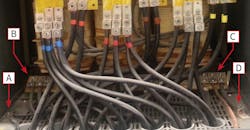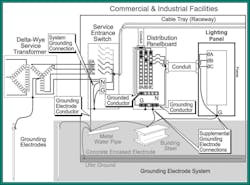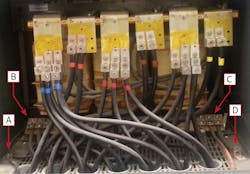The Importance of Grounding — Part 1
Per the IEEE (The Green Book), “Standard 142-2007 – Recommended Practice for Grounding Industrial and Commercial Power Systems,” the term ground is defined as “a conducting connection, whether intentional or accidental, between an electrical circuit or equipment and the earth, or to some other body that serves in place of the earth. Grounded is defined as “connected to earth or to an extended conducting body that serves instead of earth, whether the connection is intentional or accidental.” Grounding system is defined as “a system in which at least one conductor or point (usually the middle wire or neutral point of transformer or generator windings) in intentionally grounded, either solidly or through an impedance.” Equipment grounding conductor (EGC) is defined as “the conductor used to connect the non-current-carrying metal parts of the equipment, raceways, and other enclosures to the system grounded conductor, the grounding electrode conductor (GEC), or both, at the service equipment or at the source of a separately derived system.” Effectively grounded is defined as “grounded through a sufficiently low impedance such that for all system conditions the ratio of zero-sequence reactance to positive-sequence reactance (X0/X1) is positive and not greater than three (3), and the ratio of zero-sequence resistance to positive-sequence reactance (R0/X1) is positive and not greater than one (1).” A grounding system is defined as “a system that consists of all interconnected grounding connections in a specific power system and is defined by its isolation from adjacent grounding systems. The isolation is provided by transformer primary and secondary windings that are coupled by magnetic means. Thus, the system boundary is defined by the lack of a physical connection that is either metallic or through a sufficiently high impedance.”
Over six decades ago, the basic concepts within these six ground-related terms (not all of them yet published in the electrical industry at that time) were critical to electrical safety and managing the risk of electric shock in any power system — inside or outside, private or public. Because electronic equipment like LED lighting hadn’t been developed yet, these terms were not critical to electrical equipment. However, be careful with how you interpret this. Why? Because electrical system and equipment faults did occur on power systems in the 1950s, for example, and the fault current had to be “driven” to earth ground via the shortest and lowest impedance path.
This was necessary to help ensure electrical safety and manage the risk of electric shock. But when electrical disturbances occurred (not yet measured by power quality monitors as these instruments didn’t exist yet in the 1950s), they were dissipated without causing malfunctions or failure to end-use equipment. Then, disturbances were generated by the operation of contactors and circuit breakers as these power system devices were used to control customer loads. Lightning obviously existed, so disturbances did enter customer facilities and could damage electrical and simple end-use equipment. What didn’t exist at the time many early industrial plants were designed and built were solid-state electronic switching devices (e.g., power diodes and transistors in solid-state form). Thus, disturbances were not caused by the switching of solid-state switching devices in the power supplies for the normal operation of electronic equipment.
Back then, incandescent lamps were simply replaced if they were damaged by disturbances. Motors could be damaged, but if a common everyday electrical disturbance occurred back then, chances were that the motor only had to be restarted. Simple resistance heaters were not affected by common disturbances either — they just had a short perturbation in heating power and thus temperature.
In today’s electrical environment filled with end-use electronic equipment, the meaning and application of these six ground-related terms is critical to the life of electronic equipment, especially in certain customer environments — namely, industrial electrical environments. Electronic-based LED lighting used in commercial facilities can also be susceptible to malfunction and failure from common everyday electrical disturbances. As the number and power level of electronic loads increases in industrial and commercial facilities, the probability of malfunction and failure of LED lighting also increases.
Consider what is happening to the designs of electronic loads like variable-frequency drives (VFDs) and electronic power supplies used in production equipment, computers and servers. While energy efficiency is increasing, power levels are also increasing. What else is increasing? The switching frequencies of power electronics switching devices are increasing to help achieve higher energy efficiencies. Higher switching frequencies and better devices with lower switching losses means their turn-on and turn-off times are also increasing. If internal filtering — both around the power switches and in the AC input network — in these electronic loads is not improving quickly enough, then transients with faster rise times with increased frequencies generated by the operation of larger electronic loads are more threatening to end-use equipment like LED lighting than they were in older equipment.
If high-performance grounding is not designed, installed, and maintained in these facilities, electronic loads of all types will suffer, resulting in shorter equipment lives.
Figure 1 shows the basic essentials of a typical grounding system in commercial and industrial facilities. The ground system operates as a “protective layer” for the power system and its loads.
Grounding is first established at the electric utility service transformer and then transferred into the switchgear (service entrance switch, here) where a neutral-to-ground bond is established. The grounding bar in the switchgear serves to bond all the grounds together — cold metal water pipe, ground rod (electrode) at the switchgear and building steel. Other structures such as metal roofs should be bonded to this grounding bar as well. Grounding conductors must also be installed through all electrical cabinets and panels, all the way to the last panel where the end-use electronic loads are powered.
Deficiencies in any of these components that make up the grounding system for a facility will lead to an increased probability of malfunction and failure of LED lighting equipment such as LED drivers, lighting controls, and LED light engines in luminaires.
Figure 2 shows a step-down transformer transforming 3-phase 480V power to 3-phase 208V power. Lighting distribution panels operating at 208V are derived from this source. The two ground conductors bonded to the transformer enclosure at Point A are bonded on top of the gray paint applied at the transformer manufacturing facility. This paint adds a small capacitance between the two aluminum lugs and the enclosure. The lugs at Points B and C are bonded to the internal ground bar of the transformer frame. This is where the neutral-to-ground bond for the 208V transformer output is established. Two ground conductors from the upstream switchgear powering the primary of the transformer are bonded at Point B. The bare stranded copper ground conductor at Point C is bonded to the building steel above the transformer. The lug at Point D is also bonded on top of the paint and bonds the bar to the enclosure. The LED lighting system derives its ground from the two grounding conductors bonded at Point A. Thus, the ground for the LED lighting panel is “two high-frequency capacitances” away from the grounding conductors traveling from the switchgear (at Point B). For some high-frequency transients occurring on the 480V system, the LED lighting ground is “separated in ground potential” from the 480V power ground. This separation in potential will show up at the LED drivers.
Keebler is a senior power quality engineer and power systems consultant at Electrotek Concepts, Inc. in Knoxville, Tenn. He can be reached at [email protected].
About the Author
Philip Keebler
Senior Power Quality Engineer
Philip F. Keebler, MSEE has 32 years of experience in power quality (PQ) having worked for North American Philips, Electric Power Research Institute (EPRI), Electrotek Concepts & Dranetz. His experience spans across the utility revenue meter addressing PQ problems on the grid and inside residential, commercial and industrial customer facilities. His specialty areas include grounding, disturbances, harmonics, electromagnetic interference (EMI), equipment immunity, PQ monitoring, training and standards development. He serves as a Technical Advisor to PBE Engineers, LLC focused on understanding, identifying, solving and preventing (UISP) PQ problems in the industry and fostering new interest and workforce development to attract young engineers to developing careers in PQ. He can be reached at [email protected].


